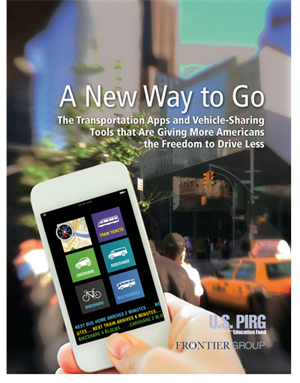Happening Now
Travel choices in the palm of your hand leads to less driving
October 1, 2013
Written By Malcolm Kenton
I have heard it said that while car keys represented freedom to generations of Americans born in the mid-20th century, the symbol and tool of freedom for the current young generation is the smartphone. This is quite literally true, as a smartphone serves as the key to one’s transportation options. A report released todayby the US Public Interest Research Group (US PIRG) has compiled evidence that the proliferation of mobile apps and vehicle sharing programs has contributed to the trend of Americans—and not just Millennials—driving less.

More Millennials are choosing to live in urban areas where driving is a hassle and owning a car is expensive because they know that a plethora of alternatives—from bus and rail transit, to shared cars and bicycles, to taxis and new chauffeur services like Uber, SideCar and Lyft, are just a few finger taps or mouse clicks away. And for trips out of town, it’s easy to use the Web to compare the cost and convenience of trains, flights and intercity buses. Your smartphone can even serve as your Amtrak ticket or airline boarding pass.
As the US PIRG report points out, the key to the success of these technologies is that they make information accessible. Riding city buses and rail transit systems, unless a given route ran frequently enough, used to require viewing or memorizing a schedule. Now, one can use a smartphone app to go to any bus stop or train station on a map, tap on it, and see when the next buses or trains are due—either based on the schedule or on real-time GPS tracking. Amtrak is getting in on this also—the company just unveiled a new live train tracking module on its Website thanks to a partnership with Google. We expect this to soon be available in the form of a mobile app.
The Web has also led to the evolution of a sharing economy, allowing individuals to make their homes, cars, bikes and other possessions available for others to rent when desired. It has also made possible car sharing companies like Zipcar and Car2go, and the aforementioned innovative chauffeur services, all of which allow one to locate an available car or taxi nearby via a GPS-based map. You can also do the same with bikeshare systems—you can find the bikeshare station nearest your origin and nearest your destination, see how many bikes are available at your origin station and how many docks are empty at your destination station.
There have also recently emerged apps that bring multiple travel modes under one roof. One of these isRideScout, a startup out of Austin, Texas. This app allows you to plug in an origin (or use your current, GPS-determined location) and a destination, and it will present you with a plethora of travel options, their estimated costs, and your estimated arrival time. It will even provide walking or driving directions from your location to or from the train, bus, or bikeshare station or the location of a shared car, and show you the condition of the shared car or the number of bikes and docks at the bikeshare station. This works whether your trip is across town or across the country—it includes Amtrak’s system, but not yet airlines or intercity buses. We anticipate that these will be added fairly soon.
US PIRG has good recommendations for public policies that would ease the way for a further shift away from costly overdependence on cars that the development of mobile technologies is abetting. Transportation providers should make as much information about routes, schedules, fares and how to make reservations or buy tickets available publicly in a format that software developers can use and incorporate into their apps. Local and regional transportation planners should integrate transportation sharing services into their planning for transit hubs and other facilities to make connections between travel modes more seamless. And governments should use the rich information these technologies put at our fingertips to assess and plan for future travel patterns driven by the enhanced transparency of alternatives to driving.
Of course, to these prescriptions we would add that passenger trains and transit should be funded at robust and predictable levels, because all the easily-accessible travel information in the world has no utility if there are no trains or buses to ride, or if the public transportation providers are unable to accommodate demand or meet their customers’ expectations due to lack of capital. When each piece of the transportation puzzle gets its fair share of public resources, we will all have an easier time getting around.
Image: US PIRG
"The Rail Passenger Association's recognition of the essential work done by SMART-TD members aboard Amtrak during this difficult period is appreciated. The Golden Spike Award serves as a testament to the compassion and dedication our conductors, assistant conductors and other workers exhibit constantly through times both ordinary and extraordinary."
Jeremy Ferguson, SMART-TD President
December 21, 2021, on the Association awarding its 2021 Golden Spike Award to the Frontline Amtrak Employees.
Comments